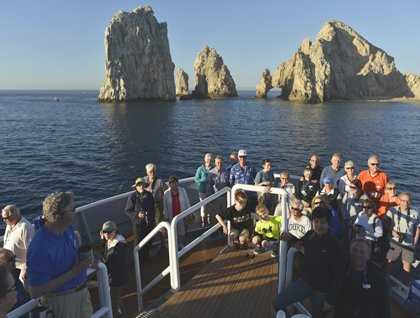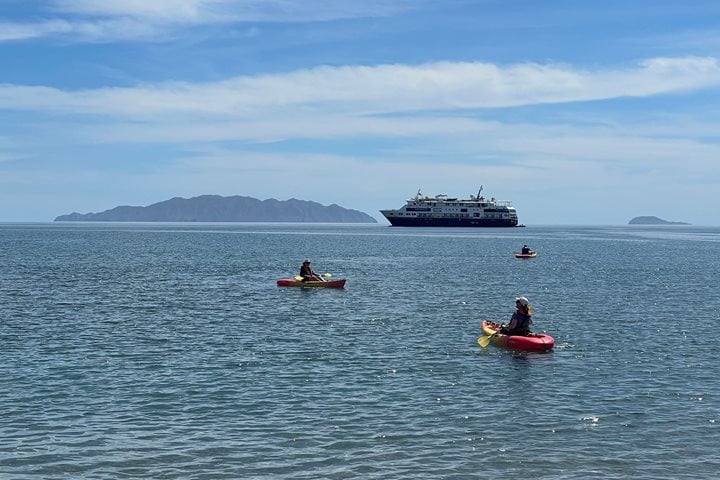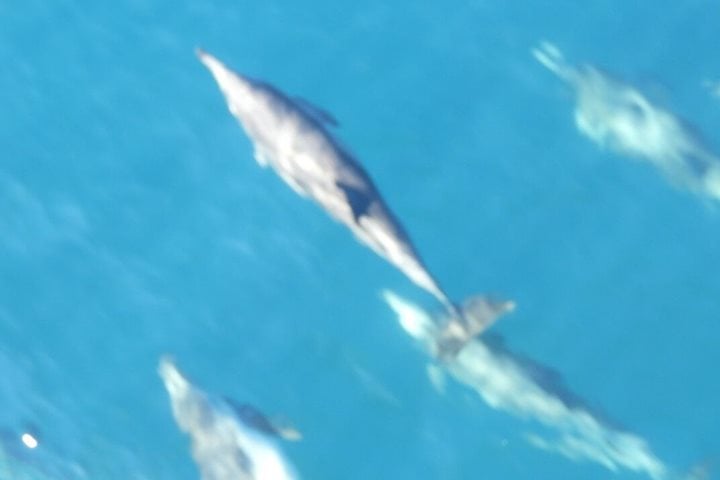Just before dawn the National Geographic Sea Bird continued making her way down the eastern side of the Baja Peninsula. The sunrise was slightly hidden by the mountains of the peninsula, but not the glow of the first light of day. As we approached Land’s End, the most southern tip of the Baja Peninsula, activity was already going strong in the most well known resort town found along this 1,000-mile peninsula. Sport fishing boats were roaring out to sea, small local fishing boats were also making their way out into the waters of the Gulf of California or Sea of Cortez. Our Captain carefully maneuvered the National Geographic Sea Bird for a well lit and close approach to a gorgeously seawater-and-weather eroded arch located in the granitic rock that makes up the very tip of Land’s End.
Cameras came out and many a portrait was taken in the early morning light as it decorated not only rock formations but also the busy resort life of Cabo San Lucas. Once photos were finished the National Geographic Sea Bird began her short passage towards our morning destination of San Jose del Cabo. This much quieter and picturesque town is located about one hour north of the tip of the Baja Peninsula near one of the early missions established in the 18th century near an estuary and good fresh water source. Century-old brick and adobe buildings, many of them proudly restored, line the main streets of old town all of which radiate out from the central plaza and church. As soon as we were tied up inside the main marina, our group left the National Geographic Sea Bird and boarded two motor coaches, which transported everyone into the town. Some of the group enjoyed a morning of bird watching in the estuary, while the rest of the group made their way to a glass blowing demonstration and a chance to walk the streets of this old mission town. Hidden in these quiet streets, small, charming high quality gallery shops offered a taste of the old flavor and spirit of Mexico, expressed through its art. A small group of us made our way to the Central Market to see the morning display of fresh fruit, vegetables, spices, fish, and all the necessary supplies for daily Mexican cuisine.
Just before lunch both motor coaches brought our group back to the National Geographic Sea Bird where a lovely lunch awaited our arrival. Meanwhile our ship left the marina and slowly made her way north and deeper into the Gulf of California in search of more marine mammals. The sea conditions were smooth and gorgeous as we made our way north towards a well known birthing and mating area for humpback whales. The afternoon and early evening were spent following small groups of whales. Cow/calf pairs and escorts were found again and again...surfacing, taking a deep breath and diving. The baby would return to the surface first, take several breaths followed by its mother and then the escort...again and again! Daylight turned to afternoon light and progressed into a sunset mixed with many soft end of day pastels. Shades of pink, peach, teal, pale yellow, and orange all swirling in very calm seas, while a nearly full moon reflected in the Gulf of California. A visual feast, yet again reminding us all of this unique place called a desert by the sea.







